Case Study: Analysis of Mr. Sunny's Conditions and Treatment Plan
VerifiedAdded on 2021/10/27
|9
|1941
|87
Case Study
AI Summary
This case study focuses on Mr. Sunny, a 93-year-old patient admitted to the hospital with multiple health issues. The analysis details his diagnosis of hospital-acquired pneumonia, atrial fibrillation, type 2 diabetes mellitus, and urinary incontinence, along with a discussion of the pathophysiology of each condition. The study explores the pharmacology of medications administered, including Metformin, Mirtazapine, Bisoprolol, and Perindopril, and their roles in managing his conditions. Investigations, including blood examinations and urinalysis, are discussed, revealing low hemoglobin and lymphocyte counts, high creatinine and urea levels, and other abnormalities indicative of kidney impairment and T2DM. The patient also experienced chronic pain and decreased safety insight. The study concludes with recommendations for improving Mr. Sunny's mobility, managing his hypertension and depression, ensuring proper fluid intake, encouraging social engagement, and addressing his visual, hearing, and speech impairments through appropriate aids and therapies. References supporting the analysis are included.
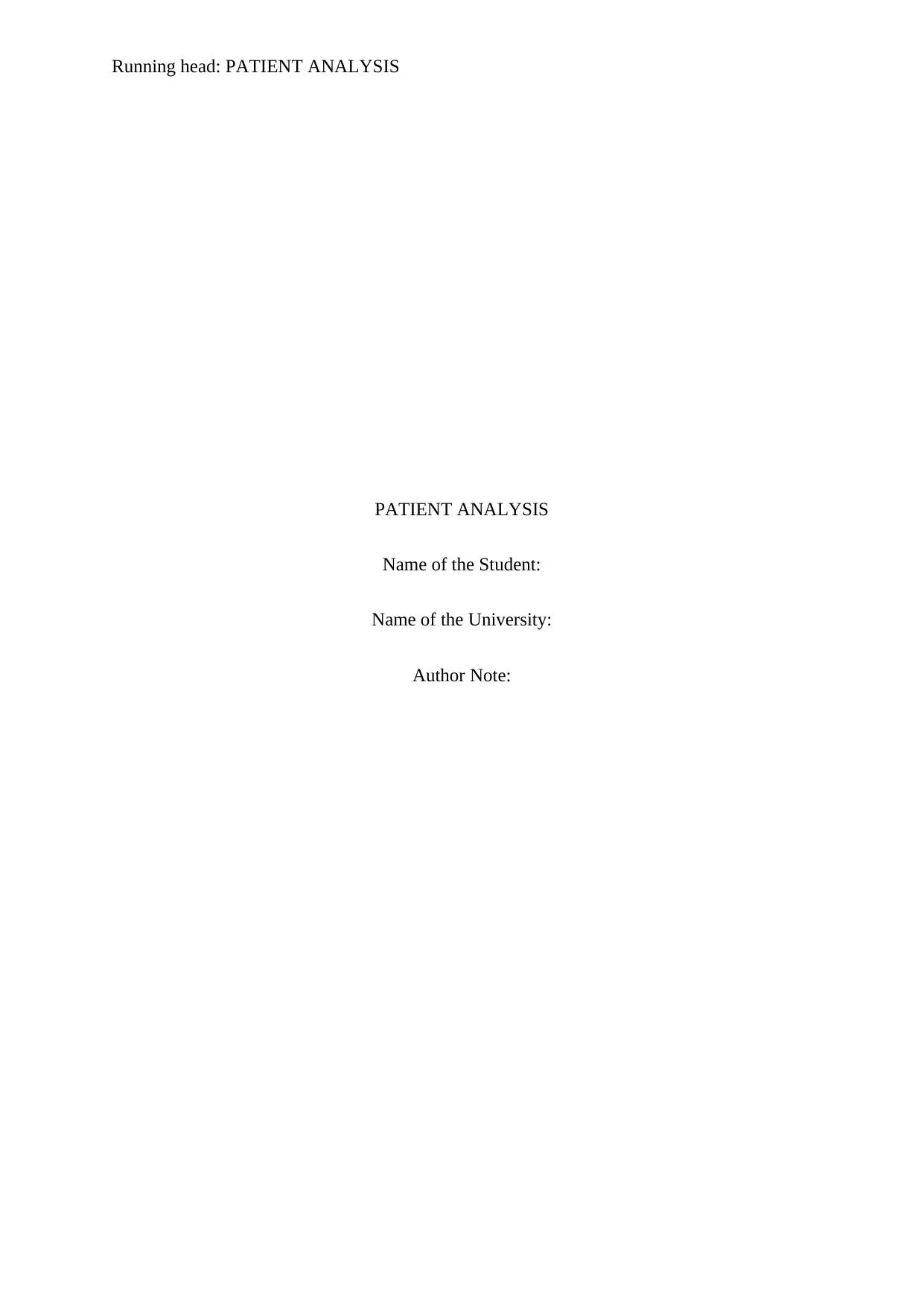
Running head: PATIENT ANALYSIS
PATIENT ANALYSIS
Name of the Student:
Name of the University:
Author Note:
PATIENT ANALYSIS
Name of the Student:
Name of the University:
Author Note:
Paraphrase This Document
Need a fresh take? Get an instant paraphrase of this document with our AI Paraphraser
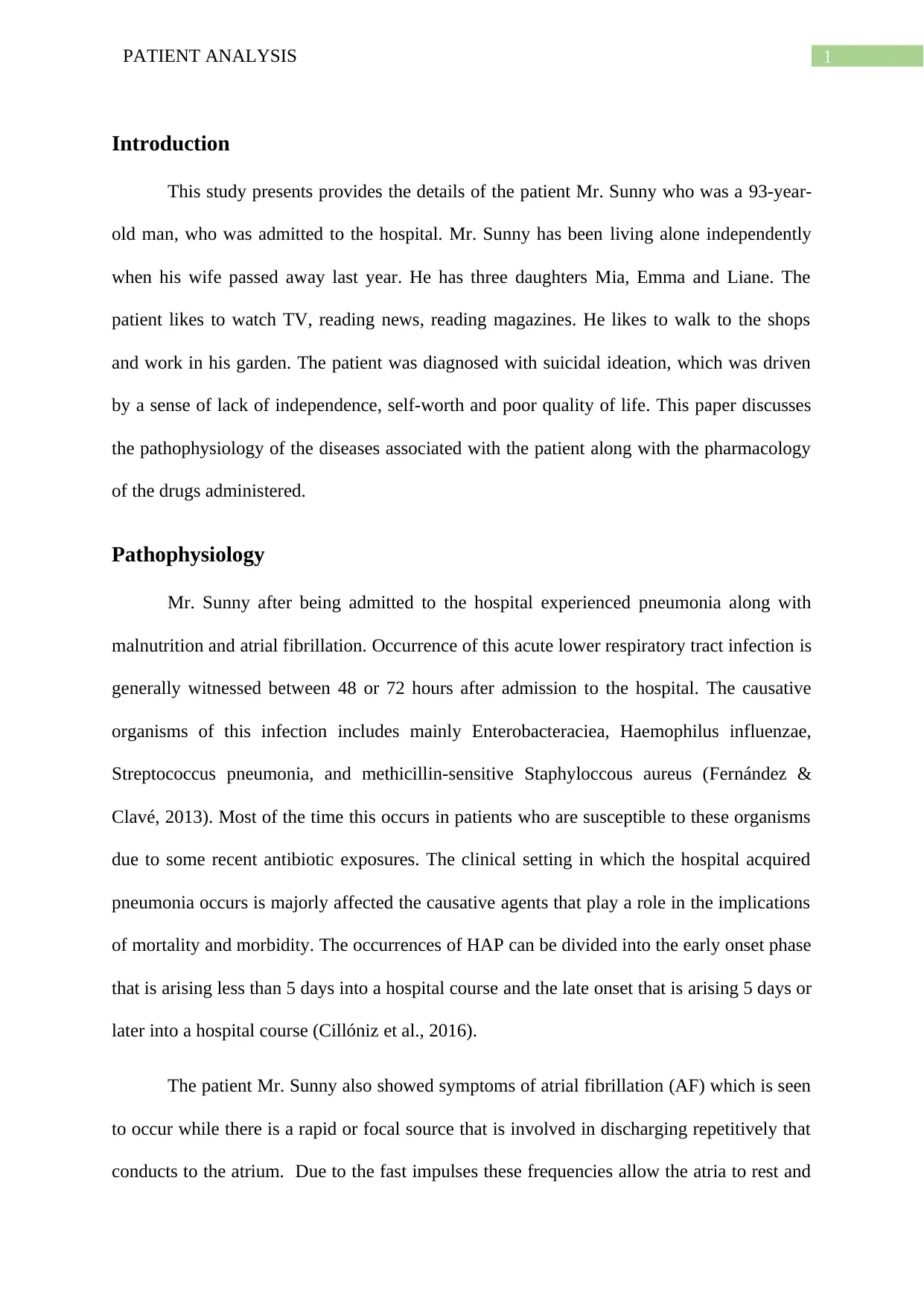
1PATIENT ANALYSIS
Introduction
This study presents provides the details of the patient Mr. Sunny who was a 93-year-
old man, who was admitted to the hospital. Mr. Sunny has been living alone independently
when his wife passed away last year. He has three daughters Mia, Emma and Liane. The
patient likes to watch TV, reading news, reading magazines. He likes to walk to the shops
and work in his garden. The patient was diagnosed with suicidal ideation, which was driven
by a sense of lack of independence, self-worth and poor quality of life. This paper discusses
the pathophysiology of the diseases associated with the patient along with the pharmacology
of the drugs administered.
Pathophysiology
Mr. Sunny after being admitted to the hospital experienced pneumonia along with
malnutrition and atrial fibrillation. Occurrence of this acute lower respiratory tract infection is
generally witnessed between 48 or 72 hours after admission to the hospital. The causative
organisms of this infection includes mainly Enterobacteraciea, Haemophilus influenzae,
Streptococcus pneumonia, and methicillin-sensitive Staphyloccous aureus (Fernández &
Clavé, 2013). Most of the time this occurs in patients who are susceptible to these organisms
due to some recent antibiotic exposures. The clinical setting in which the hospital acquired
pneumonia occurs is majorly affected the causative agents that play a role in the implications
of mortality and morbidity. The occurrences of HAP can be divided into the early onset phase
that is arising less than 5 days into a hospital course and the late onset that is arising 5 days or
later into a hospital course (Cillóniz et al., 2016).
The patient Mr. Sunny also showed symptoms of atrial fibrillation (AF) which is seen
to occur while there is a rapid or focal source that is involved in discharging repetitively that
conducts to the atrium. Due to the fast impulses these frequencies allow the atria to rest and
Introduction
This study presents provides the details of the patient Mr. Sunny who was a 93-year-
old man, who was admitted to the hospital. Mr. Sunny has been living alone independently
when his wife passed away last year. He has three daughters Mia, Emma and Liane. The
patient likes to watch TV, reading news, reading magazines. He likes to walk to the shops
and work in his garden. The patient was diagnosed with suicidal ideation, which was driven
by a sense of lack of independence, self-worth and poor quality of life. This paper discusses
the pathophysiology of the diseases associated with the patient along with the pharmacology
of the drugs administered.
Pathophysiology
Mr. Sunny after being admitted to the hospital experienced pneumonia along with
malnutrition and atrial fibrillation. Occurrence of this acute lower respiratory tract infection is
generally witnessed between 48 or 72 hours after admission to the hospital. The causative
organisms of this infection includes mainly Enterobacteraciea, Haemophilus influenzae,
Streptococcus pneumonia, and methicillin-sensitive Staphyloccous aureus (Fernández &
Clavé, 2013). Most of the time this occurs in patients who are susceptible to these organisms
due to some recent antibiotic exposures. The clinical setting in which the hospital acquired
pneumonia occurs is majorly affected the causative agents that play a role in the implications
of mortality and morbidity. The occurrences of HAP can be divided into the early onset phase
that is arising less than 5 days into a hospital course and the late onset that is arising 5 days or
later into a hospital course (Cillóniz et al., 2016).
The patient Mr. Sunny also showed symptoms of atrial fibrillation (AF) which is seen
to occur while there is a rapid or focal source that is involved in discharging repetitively that
conducts to the atrium. Due to the fast impulses these frequencies allow the atria to rest and
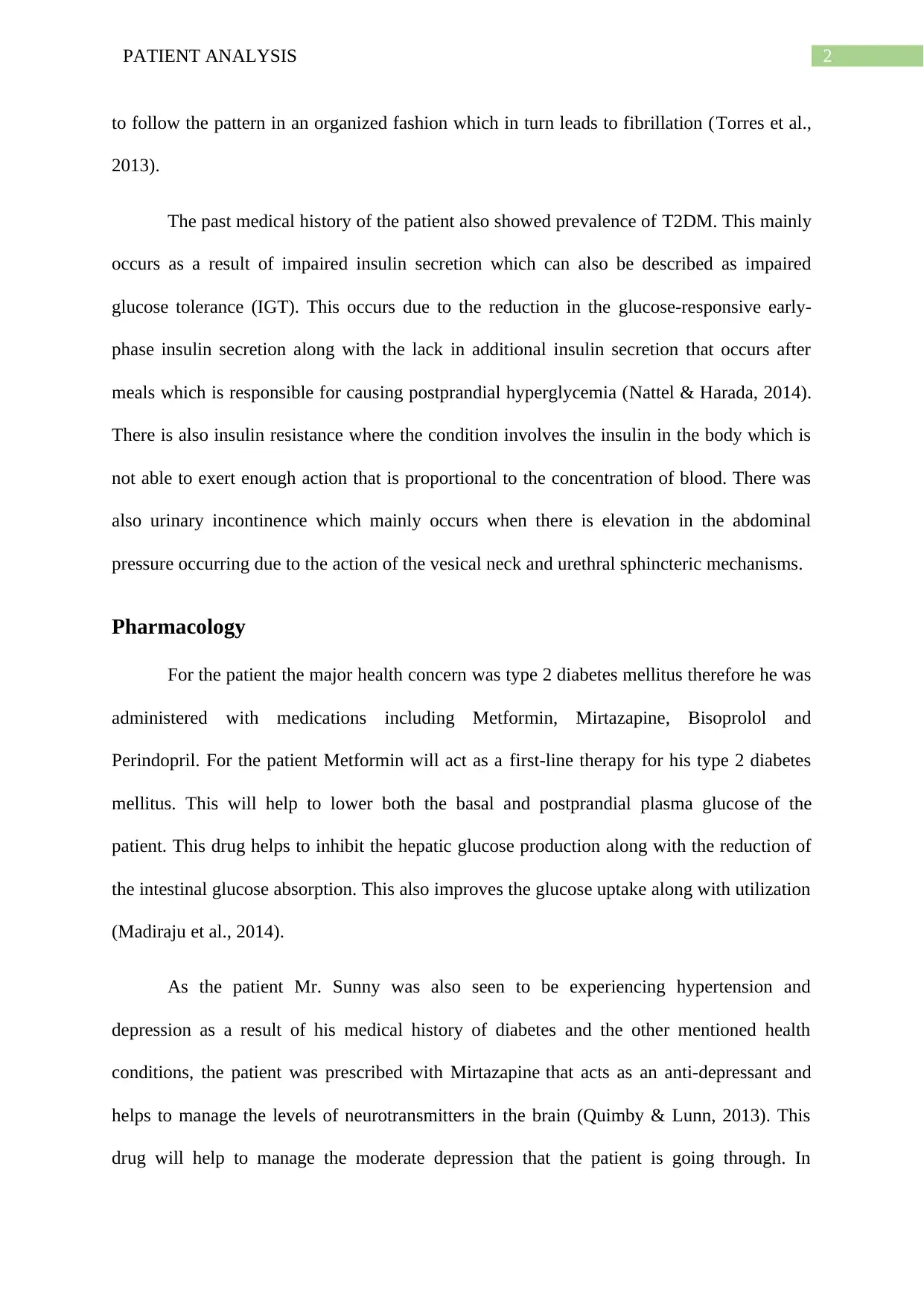
2PATIENT ANALYSIS
to follow the pattern in an organized fashion which in turn leads to fibrillation (Torres et al.,
2013).
The past medical history of the patient also showed prevalence of T2DM. This mainly
occurs as a result of impaired insulin secretion which can also be described as impaired
glucose tolerance (IGT). This occurs due to the reduction in the glucose-responsive early-
phase insulin secretion along with the lack in additional insulin secretion that occurs after
meals which is responsible for causing postprandial hyperglycemia (Nattel & Harada, 2014).
There is also insulin resistance where the condition involves the insulin in the body which is
not able to exert enough action that is proportional to the concentration of blood. There was
also urinary incontinence which mainly occurs when there is elevation in the abdominal
pressure occurring due to the action of the vesical neck and urethral sphincteric mechanisms.
Pharmacology
For the patient the major health concern was type 2 diabetes mellitus therefore he was
administered with medications including Metformin, Mirtazapine, Bisoprolol and
Perindopril. For the patient Metformin will act as a first-line therapy for his type 2 diabetes
mellitus. This will help to lower both the basal and postprandial plasma glucose of the
patient. This drug helps to inhibit the hepatic glucose production along with the reduction of
the intestinal glucose absorption. This also improves the glucose uptake along with utilization
(Madiraju et al., 2014).
As the patient Mr. Sunny was also seen to be experiencing hypertension and
depression as a result of his medical history of diabetes and the other mentioned health
conditions, the patient was prescribed with Mirtazapine that acts as an anti-depressant and
helps to manage the levels of neurotransmitters in the brain (Quimby & Lunn, 2013). This
drug will help to manage the moderate depression that the patient is going through. In
to follow the pattern in an organized fashion which in turn leads to fibrillation (Torres et al.,
2013).
The past medical history of the patient also showed prevalence of T2DM. This mainly
occurs as a result of impaired insulin secretion which can also be described as impaired
glucose tolerance (IGT). This occurs due to the reduction in the glucose-responsive early-
phase insulin secretion along with the lack in additional insulin secretion that occurs after
meals which is responsible for causing postprandial hyperglycemia (Nattel & Harada, 2014).
There is also insulin resistance where the condition involves the insulin in the body which is
not able to exert enough action that is proportional to the concentration of blood. There was
also urinary incontinence which mainly occurs when there is elevation in the abdominal
pressure occurring due to the action of the vesical neck and urethral sphincteric mechanisms.
Pharmacology
For the patient the major health concern was type 2 diabetes mellitus therefore he was
administered with medications including Metformin, Mirtazapine, Bisoprolol and
Perindopril. For the patient Metformin will act as a first-line therapy for his type 2 diabetes
mellitus. This will help to lower both the basal and postprandial plasma glucose of the
patient. This drug helps to inhibit the hepatic glucose production along with the reduction of
the intestinal glucose absorption. This also improves the glucose uptake along with utilization
(Madiraju et al., 2014).
As the patient Mr. Sunny was also seen to be experiencing hypertension and
depression as a result of his medical history of diabetes and the other mentioned health
conditions, the patient was prescribed with Mirtazapine that acts as an anti-depressant and
helps to manage the levels of neurotransmitters in the brain (Quimby & Lunn, 2013). This
drug will help to manage the moderate depression that the patient is going through. In
⊘ This is a preview!⊘
Do you want full access?
Subscribe today to unlock all pages.

Trusted by 1+ million students worldwide
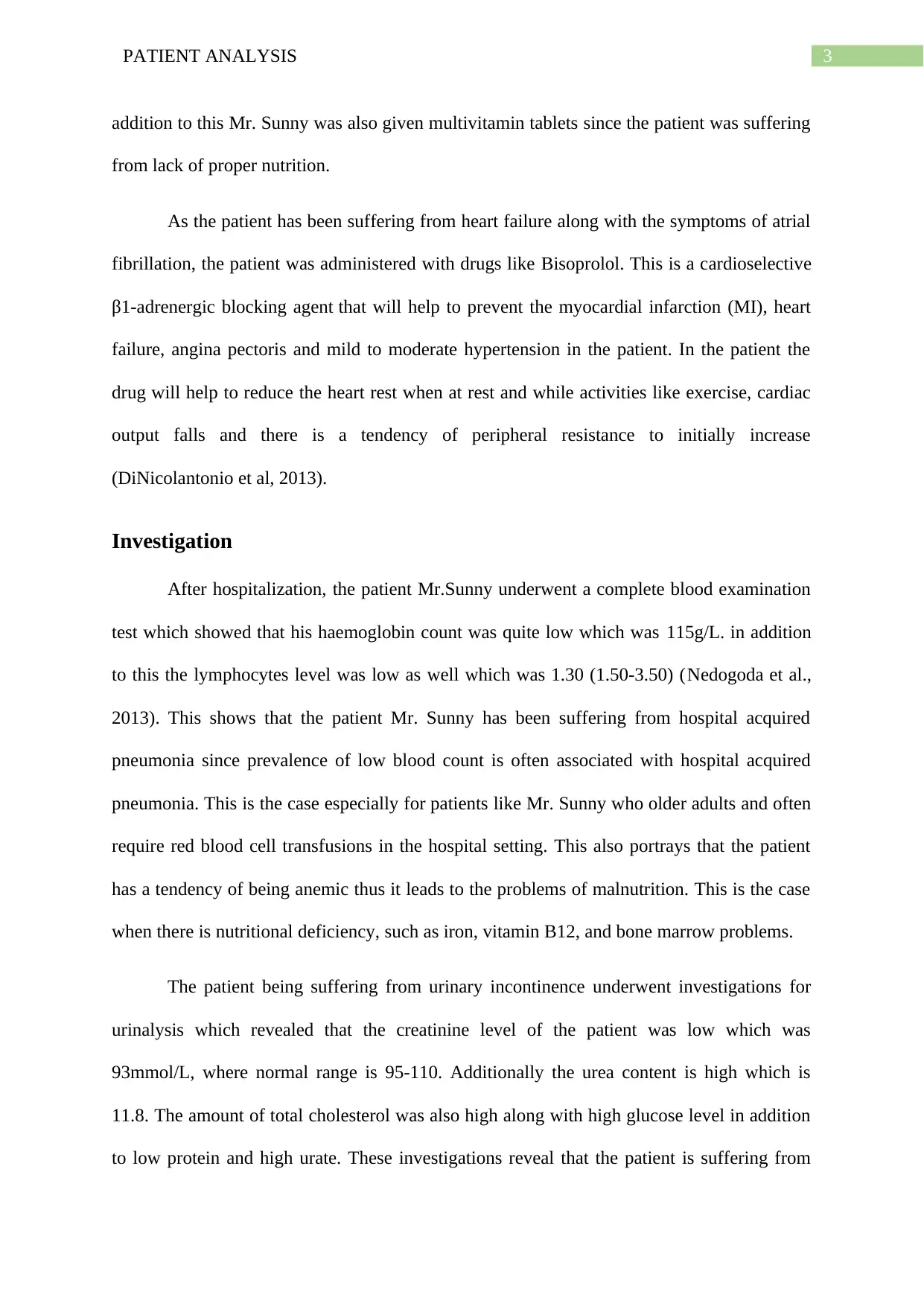
3PATIENT ANALYSIS
addition to this Mr. Sunny was also given multivitamin tablets since the patient was suffering
from lack of proper nutrition.
As the patient has been suffering from heart failure along with the symptoms of atrial
fibrillation, the patient was administered with drugs like Bisoprolol. This is a cardioselective
β1-adrenergic blocking agent that will help to prevent the myocardial infarction (MI), heart
failure, angina pectoris and mild to moderate hypertension in the patient. In the patient the
drug will help to reduce the heart rest when at rest and while activities like exercise, cardiac
output falls and there is a tendency of peripheral resistance to initially increase
(DiNicolantonio et al, 2013).
Investigation
After hospitalization, the patient Mr.Sunny underwent a complete blood examination
test which showed that his haemoglobin count was quite low which was 115g/L. in addition
to this the lymphocytes level was low as well which was 1.30 (1.50-3.50) (Nedogoda et al.,
2013). This shows that the patient Mr. Sunny has been suffering from hospital acquired
pneumonia since prevalence of low blood count is often associated with hospital acquired
pneumonia. This is the case especially for patients like Mr. Sunny who older adults and often
require red blood cell transfusions in the hospital setting. This also portrays that the patient
has a tendency of being anemic thus it leads to the problems of malnutrition. This is the case
when there is nutritional deficiency, such as iron, vitamin B12, and bone marrow problems.
The patient being suffering from urinary incontinence underwent investigations for
urinalysis which revealed that the creatinine level of the patient was low which was
93mmol/L, where normal range is 95-110. Additionally the urea content is high which is
11.8. The amount of total cholesterol was also high along with high glucose level in addition
to low protein and high urate. These investigations reveal that the patient is suffering from
addition to this Mr. Sunny was also given multivitamin tablets since the patient was suffering
from lack of proper nutrition.
As the patient has been suffering from heart failure along with the symptoms of atrial
fibrillation, the patient was administered with drugs like Bisoprolol. This is a cardioselective
β1-adrenergic blocking agent that will help to prevent the myocardial infarction (MI), heart
failure, angina pectoris and mild to moderate hypertension in the patient. In the patient the
drug will help to reduce the heart rest when at rest and while activities like exercise, cardiac
output falls and there is a tendency of peripheral resistance to initially increase
(DiNicolantonio et al, 2013).
Investigation
After hospitalization, the patient Mr.Sunny underwent a complete blood examination
test which showed that his haemoglobin count was quite low which was 115g/L. in addition
to this the lymphocytes level was low as well which was 1.30 (1.50-3.50) (Nedogoda et al.,
2013). This shows that the patient Mr. Sunny has been suffering from hospital acquired
pneumonia since prevalence of low blood count is often associated with hospital acquired
pneumonia. This is the case especially for patients like Mr. Sunny who older adults and often
require red blood cell transfusions in the hospital setting. This also portrays that the patient
has a tendency of being anemic thus it leads to the problems of malnutrition. This is the case
when there is nutritional deficiency, such as iron, vitamin B12, and bone marrow problems.
The patient being suffering from urinary incontinence underwent investigations for
urinalysis which revealed that the creatinine level of the patient was low which was
93mmol/L, where normal range is 95-110. Additionally the urea content is high which is
11.8. The amount of total cholesterol was also high along with high glucose level in addition
to low protein and high urate. These investigations reveal that the patient is suffering from
Paraphrase This Document
Need a fresh take? Get an instant paraphrase of this document with our AI Paraphraser
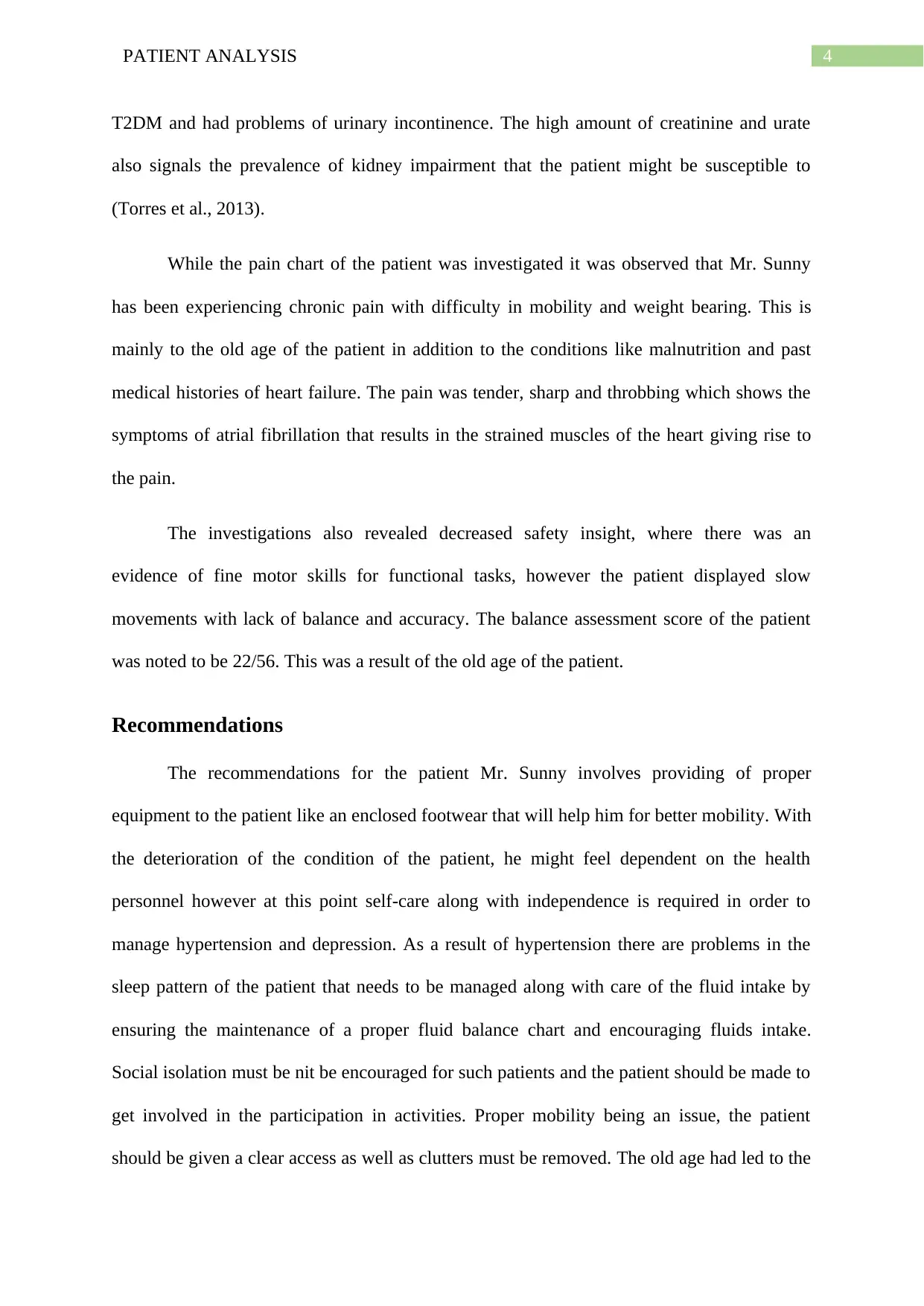
4PATIENT ANALYSIS
T2DM and had problems of urinary incontinence. The high amount of creatinine and urate
also signals the prevalence of kidney impairment that the patient might be susceptible to
(Torres et al., 2013).
While the pain chart of the patient was investigated it was observed that Mr. Sunny
has been experiencing chronic pain with difficulty in mobility and weight bearing. This is
mainly to the old age of the patient in addition to the conditions like malnutrition and past
medical histories of heart failure. The pain was tender, sharp and throbbing which shows the
symptoms of atrial fibrillation that results in the strained muscles of the heart giving rise to
the pain.
The investigations also revealed decreased safety insight, where there was an
evidence of fine motor skills for functional tasks, however the patient displayed slow
movements with lack of balance and accuracy. The balance assessment score of the patient
was noted to be 22/56. This was a result of the old age of the patient.
Recommendations
The recommendations for the patient Mr. Sunny involves providing of proper
equipment to the patient like an enclosed footwear that will help him for better mobility. With
the deterioration of the condition of the patient, he might feel dependent on the health
personnel however at this point self-care along with independence is required in order to
manage hypertension and depression. As a result of hypertension there are problems in the
sleep pattern of the patient that needs to be managed along with care of the fluid intake by
ensuring the maintenance of a proper fluid balance chart and encouraging fluids intake.
Social isolation must be nit be encouraged for such patients and the patient should be made to
get involved in the participation in activities. Proper mobility being an issue, the patient
should be given a clear access as well as clutters must be removed. The old age had led to the
T2DM and had problems of urinary incontinence. The high amount of creatinine and urate
also signals the prevalence of kidney impairment that the patient might be susceptible to
(Torres et al., 2013).
While the pain chart of the patient was investigated it was observed that Mr. Sunny
has been experiencing chronic pain with difficulty in mobility and weight bearing. This is
mainly to the old age of the patient in addition to the conditions like malnutrition and past
medical histories of heart failure. The pain was tender, sharp and throbbing which shows the
symptoms of atrial fibrillation that results in the strained muscles of the heart giving rise to
the pain.
The investigations also revealed decreased safety insight, where there was an
evidence of fine motor skills for functional tasks, however the patient displayed slow
movements with lack of balance and accuracy. The balance assessment score of the patient
was noted to be 22/56. This was a result of the old age of the patient.
Recommendations
The recommendations for the patient Mr. Sunny involves providing of proper
equipment to the patient like an enclosed footwear that will help him for better mobility. With
the deterioration of the condition of the patient, he might feel dependent on the health
personnel however at this point self-care along with independence is required in order to
manage hypertension and depression. As a result of hypertension there are problems in the
sleep pattern of the patient that needs to be managed along with care of the fluid intake by
ensuring the maintenance of a proper fluid balance chart and encouraging fluids intake.
Social isolation must be nit be encouraged for such patients and the patient should be made to
get involved in the participation in activities. Proper mobility being an issue, the patient
should be given a clear access as well as clutters must be removed. The old age had led to the
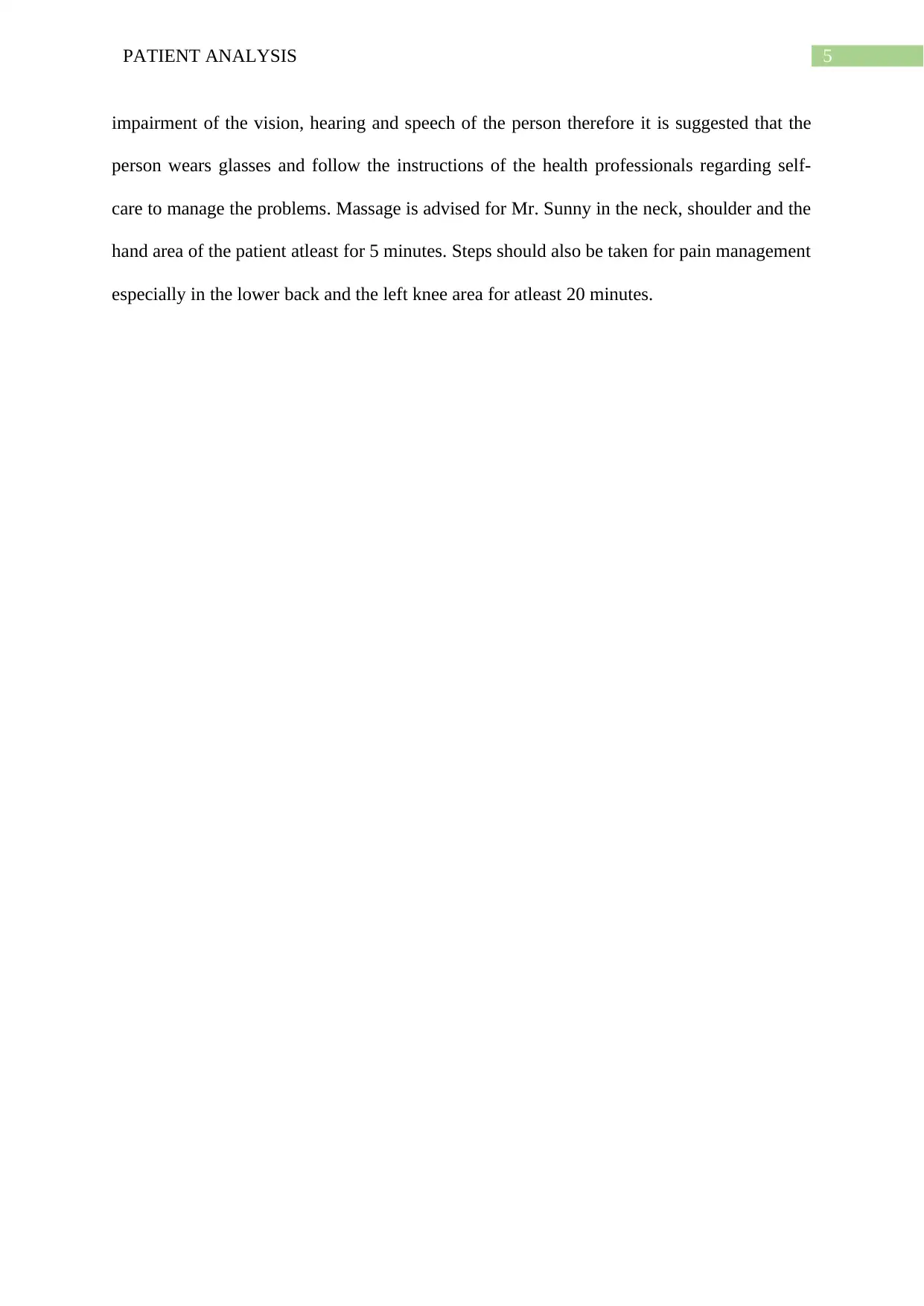
5PATIENT ANALYSIS
impairment of the vision, hearing and speech of the person therefore it is suggested that the
person wears glasses and follow the instructions of the health professionals regarding self-
care to manage the problems. Massage is advised for Mr. Sunny in the neck, shoulder and the
hand area of the patient atleast for 5 minutes. Steps should also be taken for pain management
especially in the lower back and the left knee area for atleast 20 minutes.
impairment of the vision, hearing and speech of the person therefore it is suggested that the
person wears glasses and follow the instructions of the health professionals regarding self-
care to manage the problems. Massage is advised for Mr. Sunny in the neck, shoulder and the
hand area of the patient atleast for 5 minutes. Steps should also be taken for pain management
especially in the lower back and the left knee area for atleast 20 minutes.
⊘ This is a preview!⊘
Do you want full access?
Subscribe today to unlock all pages.

Trusted by 1+ million students worldwide

6PATIENT ANALYSIS
Paraphrase This Document
Need a fresh take? Get an instant paraphrase of this document with our AI Paraphraser
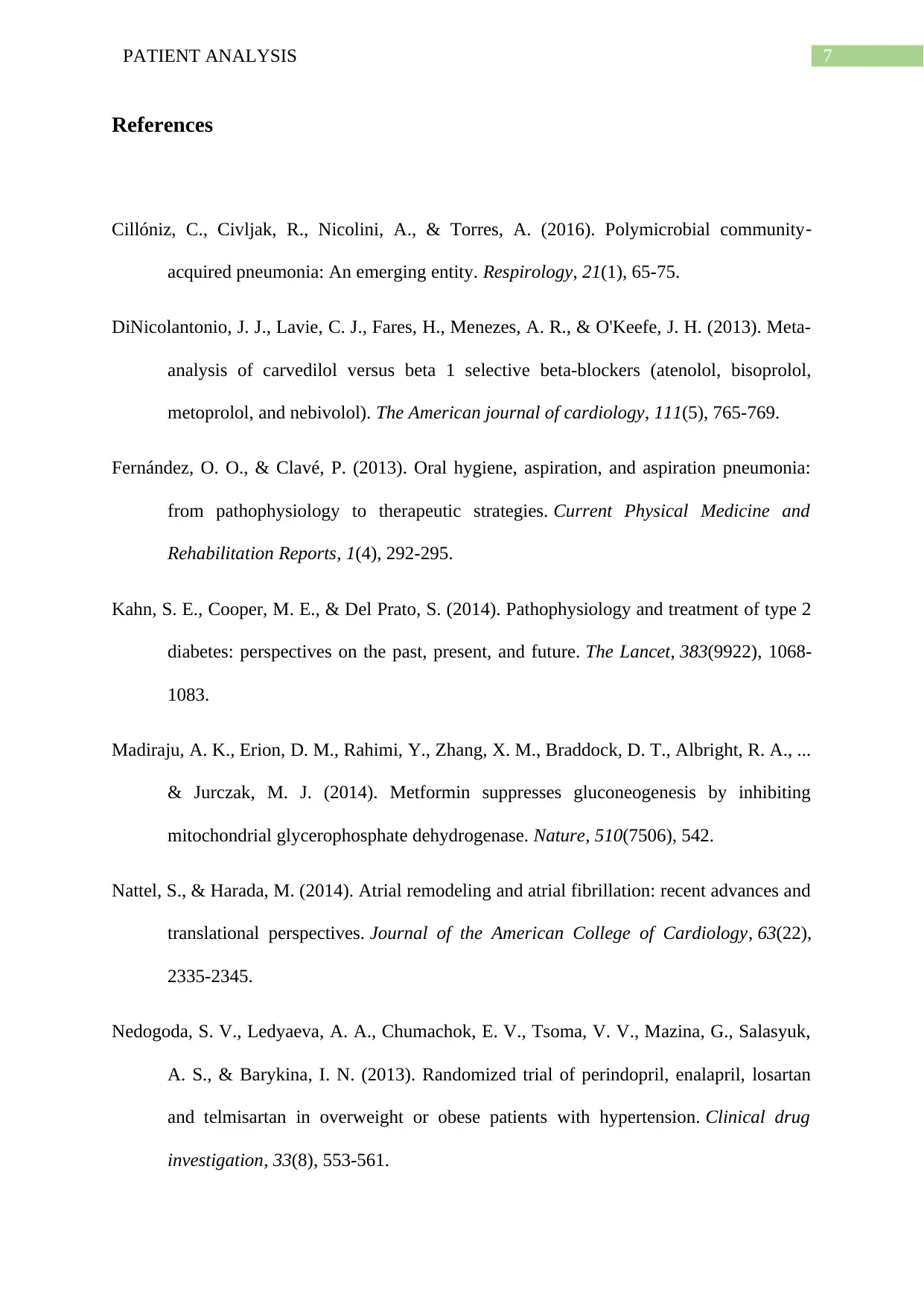
7PATIENT ANALYSIS
References
Cillóniz, C., Civljak, R., Nicolini, A., & Torres, A. (2016). Polymicrobial community‐
acquired pneumonia: An emerging entity. Respirology, 21(1), 65-75.
DiNicolantonio, J. J., Lavie, C. J., Fares, H., Menezes, A. R., & O'Keefe, J. H. (2013). Meta-
analysis of carvedilol versus beta 1 selective beta-blockers (atenolol, bisoprolol,
metoprolol, and nebivolol). The American journal of cardiology, 111(5), 765-769.
Fernández, O. O., & Clavé, P. (2013). Oral hygiene, aspiration, and aspiration pneumonia:
from pathophysiology to therapeutic strategies. Current Physical Medicine and
Rehabilitation Reports, 1(4), 292-295.
Kahn, S. E., Cooper, M. E., & Del Prato, S. (2014). Pathophysiology and treatment of type 2
diabetes: perspectives on the past, present, and future. The Lancet, 383(9922), 1068-
1083.
Madiraju, A. K., Erion, D. M., Rahimi, Y., Zhang, X. M., Braddock, D. T., Albright, R. A., ...
& Jurczak, M. J. (2014). Metformin suppresses gluconeogenesis by inhibiting
mitochondrial glycerophosphate dehydrogenase. Nature, 510(7506), 542.
Nattel, S., & Harada, M. (2014). Atrial remodeling and atrial fibrillation: recent advances and
translational perspectives. Journal of the American College of Cardiology, 63(22),
2335-2345.
Nedogoda, S. V., Ledyaeva, A. A., Chumachok, E. V., Tsoma, V. V., Mazina, G., Salasyuk,
A. S., & Barykina, I. N. (2013). Randomized trial of perindopril, enalapril, losartan
and telmisartan in overweight or obese patients with hypertension. Clinical drug
investigation, 33(8), 553-561.
References
Cillóniz, C., Civljak, R., Nicolini, A., & Torres, A. (2016). Polymicrobial community‐
acquired pneumonia: An emerging entity. Respirology, 21(1), 65-75.
DiNicolantonio, J. J., Lavie, C. J., Fares, H., Menezes, A. R., & O'Keefe, J. H. (2013). Meta-
analysis of carvedilol versus beta 1 selective beta-blockers (atenolol, bisoprolol,
metoprolol, and nebivolol). The American journal of cardiology, 111(5), 765-769.
Fernández, O. O., & Clavé, P. (2013). Oral hygiene, aspiration, and aspiration pneumonia:
from pathophysiology to therapeutic strategies. Current Physical Medicine and
Rehabilitation Reports, 1(4), 292-295.
Kahn, S. E., Cooper, M. E., & Del Prato, S. (2014). Pathophysiology and treatment of type 2
diabetes: perspectives on the past, present, and future. The Lancet, 383(9922), 1068-
1083.
Madiraju, A. K., Erion, D. M., Rahimi, Y., Zhang, X. M., Braddock, D. T., Albright, R. A., ...
& Jurczak, M. J. (2014). Metformin suppresses gluconeogenesis by inhibiting
mitochondrial glycerophosphate dehydrogenase. Nature, 510(7506), 542.
Nattel, S., & Harada, M. (2014). Atrial remodeling and atrial fibrillation: recent advances and
translational perspectives. Journal of the American College of Cardiology, 63(22),
2335-2345.
Nedogoda, S. V., Ledyaeva, A. A., Chumachok, E. V., Tsoma, V. V., Mazina, G., Salasyuk,
A. S., & Barykina, I. N. (2013). Randomized trial of perindopril, enalapril, losartan
and telmisartan in overweight or obese patients with hypertension. Clinical drug
investigation, 33(8), 553-561.
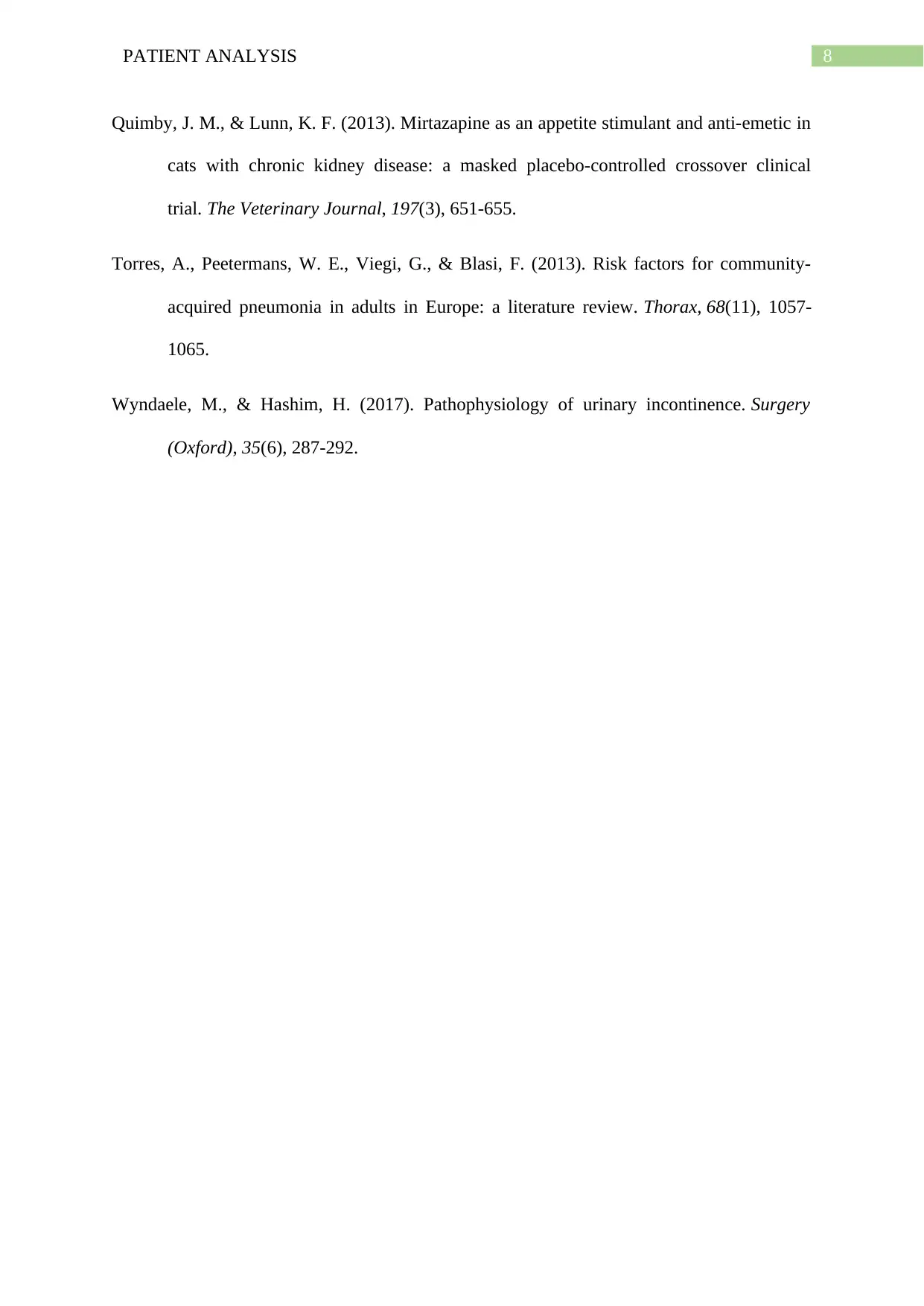
8PATIENT ANALYSIS
Quimby, J. M., & Lunn, K. F. (2013). Mirtazapine as an appetite stimulant and anti-emetic in
cats with chronic kidney disease: a masked placebo-controlled crossover clinical
trial. The Veterinary Journal, 197(3), 651-655.
Torres, A., Peetermans, W. E., Viegi, G., & Blasi, F. (2013). Risk factors for community-
acquired pneumonia in adults in Europe: a literature review. Thorax, 68(11), 1057-
1065.
Wyndaele, M., & Hashim, H. (2017). Pathophysiology of urinary incontinence. Surgery
(Oxford), 35(6), 287-292.
Quimby, J. M., & Lunn, K. F. (2013). Mirtazapine as an appetite stimulant and anti-emetic in
cats with chronic kidney disease: a masked placebo-controlled crossover clinical
trial. The Veterinary Journal, 197(3), 651-655.
Torres, A., Peetermans, W. E., Viegi, G., & Blasi, F. (2013). Risk factors for community-
acquired pneumonia in adults in Europe: a literature review. Thorax, 68(11), 1057-
1065.
Wyndaele, M., & Hashim, H. (2017). Pathophysiology of urinary incontinence. Surgery
(Oxford), 35(6), 287-292.
⊘ This is a preview!⊘
Do you want full access?
Subscribe today to unlock all pages.

Trusted by 1+ million students worldwide
1 out of 9
Related Documents
Your All-in-One AI-Powered Toolkit for Academic Success.
+13062052269
info@desklib.com
Available 24*7 on WhatsApp / Email
![[object Object]](/_next/static/media/star-bottom.7253800d.svg)
Unlock your academic potential
Copyright © 2020–2025 A2Z Services. All Rights Reserved. Developed and managed by ZUCOL.





